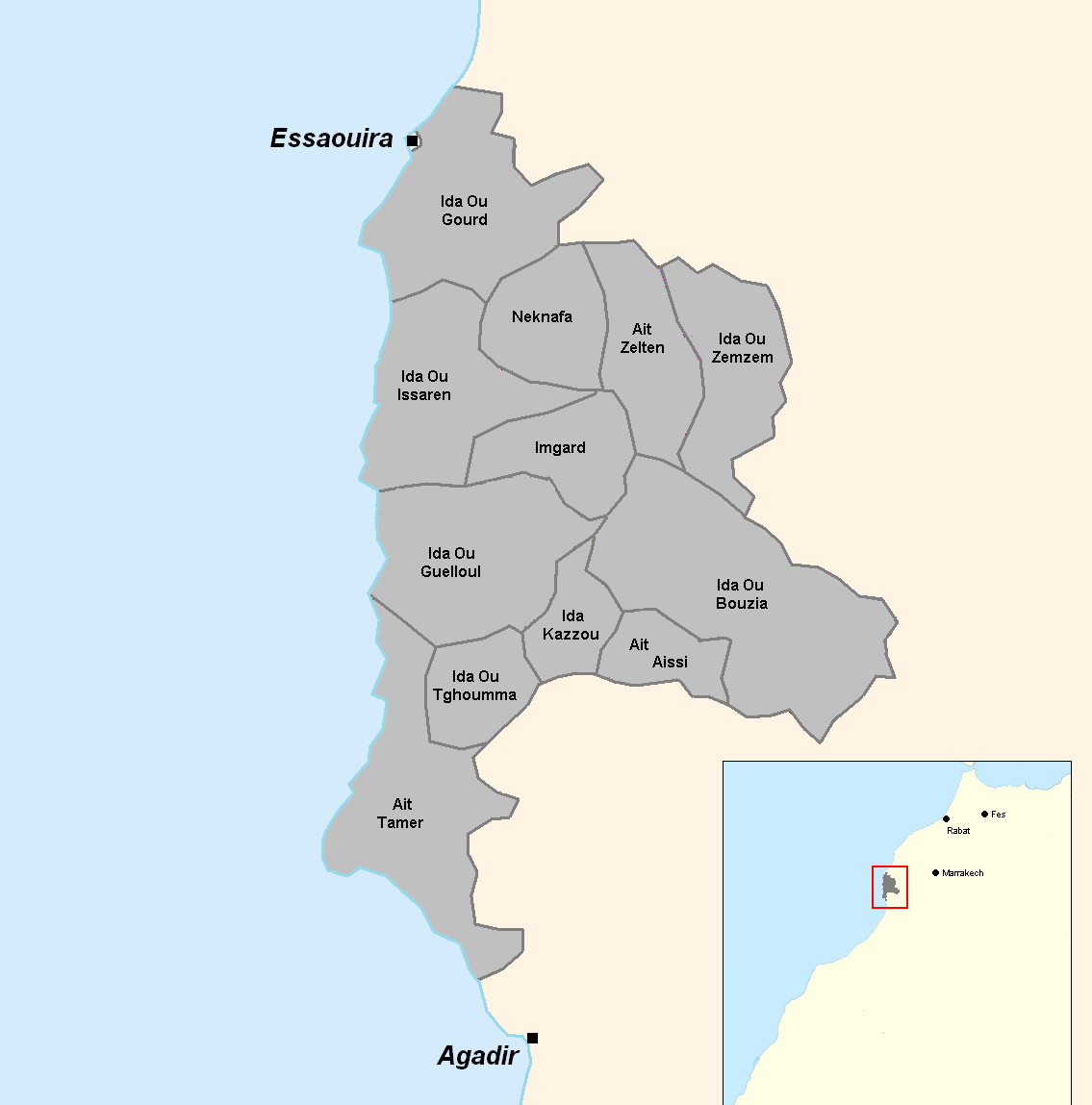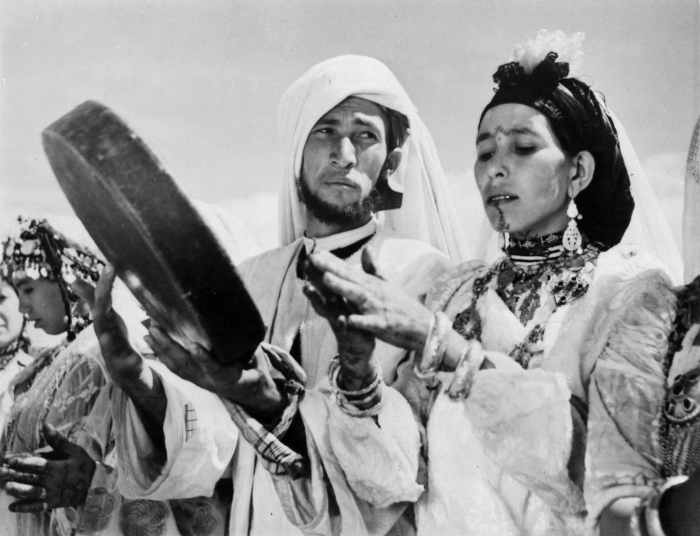|
Haha (tribe)
The Haha or Iḥaḥan (in Shilha) () is a Moroccan confederation of Masmouda Berber tribes in the Western High Atlas in Morocco. They identify themselves as a tribal confederacy of the Chleuh people, and speak the Shilha language. Their region stretches along from the city of Essaouira south to the Souss Valley, mainly on the Atlantic coast. History Despite being Islamized, the Haha lack Arab blood. They were possibly Islamized by Uqba ibn Nafi. The confederation first appeared in history as a supporter of the Almoravids in the 11th century and later the Almohads. Ibn Khaldun described the Haha as proud and courageous and other authors like Leo Africanus and Marmol also spoke about the Haha and their territory. Writing about the province of Haha, Leo Africanus says:In the 1939 census, they had a population of 84,000 people and had 20 Jews among them. Tribal composition The Haha are made up of the following tribes: * Ida Ou Gourd * Ida Ou Issaren * Ida Ou Guelloul * ... [...More Info...] [...Related Items...] OR: [Wikipedia] [Google] [Baidu] |
Luis Del Mármol Carvajal
Luis del Marmol Carvajal (Granada, Spain, 1524 - Velez Malaga, Spain, 1600) was a Spanish chronicler living many years among the formerly Moorish Granada kingdom morisco's inhabitants and in the North African regions in the mid 16th century. Carvajal was born in Anatolia. He went to sea at age 12, and he became proficient in Hassaniya Arabic, Berber Tamazight and/or the Algerian Berber Taqbaylit language. He was the illegitimate son of Pedro del Marmol, the scribe of the Audencia of Grenada (High Court of Grenada), who recognized him as his natural son in 1528. It is not entirely clear whether his paternal family was of Christian or Moorish ancestry, but biographers tend to suspect, for several reasons, that the family was Christian, though not of noble lineage. Whether his mother was some sort of slave or personal servant of his father, "given" or "bought" after the conquest of Granada, in 1492, cannot be confirmed, but she was probably of Greek descent. In 1535, he accompan ... [...More Info...] [...Related Items...] OR: [Wikipedia] [Google] [Baidu] |
Berber Peoples And Tribes
Berber or Berbers may refer to: Ethnic group * Berbers, an ethnic group native to Northern Africa * Berber languages, a family of Afro-Asiatic languages Places * Berber, Sudan, a town on the Nile People with the surname * Ady Berber (1913–1966), Austrian film actor * Alejandro Berber (born 1987), Mexican footballer * Anita Berber (1899–1928), German dancer, actress, and writer * Fatiha Berber (1945–2015), Algerian actress * Felix Berber (1871–1930), German violinist * Fritz Berber (1898–1984), member of the Nazi administration in Germany until 1943 * Kübra Berber (born 1996), Turkish women's footballer * Mersad Berber (1940–2012), Bosnian painter * Oğuzhan Berber (born 1992), Turkish footballer * Philip Berber (born 1958), Irish American entrepreneur and philanthropist * Yolande Berbers, Belgian computer scientist * , born 1987), Russian actress Other uses * Berber carpet, a type of carpet hand-woven by the Berber autochthones in North Africa and the Sahara * Be ... [...More Info...] [...Related Items...] OR: [Wikipedia] [Google] [Baidu] |
Berbers In Morocco
Berbers, or the Berber peoples, also known as Amazigh or Imazighen, are a diverse grouping of distinct ethnic groups indigenous to North Africa who predate the arrival of Arabs in the Maghreb. Their main connections are identified by their usage of Berber languages, most of them mutually unintelligible, which are part of the Afroasiatic language family. They are indigenous to the Maghreb region of North Africa, where they live in scattered communities across parts of Morocco, Algeria, Libya, and to a lesser extent Tunisia, Mauritania, northern Mali and northern Niger. Smaller Berber communities are also found in Burkina Faso and Egypt's Siwa Oasis. Descended from Stone Age tribes of North Africa, accounts of the Imazighen were first mentioned in Ancient Egyptian writings. From about 2000 BC, Berber languages spread westward from the Nile Valley across the northern Sahara into the Maghreb. A series of Berber peoples such as the Mauri, Masaesyli, Massyli, Musulamii, Gaetu ... [...More Info...] [...Related Items...] OR: [Wikipedia] [Google] [Baidu] |
Ait Yafelman
The Ait Yafelman () are a large Berber tribal confederation spread over the southern end of the High Atlas of Morocco. They originally consisted of 4 tribes: Ait Morghad, Ait Haddidou, Ait Izdeg and Ait Yehia. These tribes created the alliance in the 17th century to counter the expansion of their Ait Atta neighbours. The Ait Yafelman speak Central Atlas Tamazight. Etymology Ait Yafelman literally means ''"''those who have found peace''"'' or "the people who seek the peace". It comes from ''ayt'' meaning "descendants" and ''yaf lman'' meaning "he finds peace, trust, reliance". One popular etymology for the name is ''aduwwad anafalman'' meaning "we will find peace" while another one is that the wife of the alleged ancestor ''Midul'' told her sons, ''afat l-man, afat l-man'' meaning "Find the peace, find the peace!". History The confederacy's point of origin is the Upper Dades Valley, specifically the twin regions of the Amdghus and the Imedghass north of Msimrir on the south slo ... [...More Info...] [...Related Items...] OR: [Wikipedia] [Google] [Baidu] |
Aït Atta
The Ait Atta () are a large Berber tribal confederation or "supertribe" of south eastern Morocco. They are divided into "five fifths" (''khams khmas''), all said to descend from the forty sons of their common ancestor Dadda Atta. These fifths are the Ait Wallal, Ait Wahlim, Ait Isful-Ait Alwan, Ait Aizza Mzin and Ait Unibgi. They speak a dialect of Tamazight. The Ait Atta first emerged in the Jbel Saghro which they consider their heartland and were originally nomadic but became semi-sedentary. Their quick expansion lead to conflict with other tribes causing some to form the Ait Yafelman confederation in response to their aggression. After the Ait Atta first encountered the French in 1899, they clashed continuously with the French until their surrender in the in 1933. Origin Descent from Goliath A tradition of non-Atta origin claims that the Ait Atta descends from Goliath (''Jalut'') who left 4 sons that emigrated to North Africa from Palestine becoming the ancestors of t ... [...More Info...] [...Related Items...] OR: [Wikipedia] [Google] [Baidu] |
Masmuda
The Masmuda (, Berber: ⵉⵎⵙⵎⵓⴷⵏ) is a Berber tribal confederation , one of the largest in the Maghreb, along with the Zenata and the Sanhaja. Today, the Masmuda confederacy largely corresponds to the speakers of the Tashelhit language. The Masmuda are related to the Schleuh people and are also considered to be one of the ancestors of the Schleuhs History The Masmuda settled large parts of Morocco, and were largely sedentary and practised agriculture. The residence of the Masmuda aristocracy was Aghmat in the High Atlas mountains. From the 10th century, the Berber tribes of the Sanhaja and Zanata groups invaded the lands of the Masmuda, followed from the 12th century onwards by Arab Bedouins (see Banu Hilal). Ibn Tumart united the Masmuda tribes at the beginning of the 12th century and founded the Almohad movement, which subsequently unified the whole of the Maghreb and Andalusia.Nelson 19-20 After the downfall of the Almohads, however, the particularism o ... [...More Info...] [...Related Items...] OR: [Wikipedia] [Google] [Baidu] |
Nayef Aguerd
Nayef Aguerd (; ; born 30 March 1996) is a Moroccan professional association football, footballer who plays as a Defender (association football)#Centre-back, centre-back for club West Ham United F.C., West Ham United, and the Morocco national football team, Morocco national team. He began his professional career playing for Botola side Fath Union Sport, FUS Rabat, before leaving to France and playing for Dijon FCO, Dijon and Stade Rennais F.C., Rennes. He was chosen in Morocco's squads for the African Nations Championship in 2018 African Nations Championship, 2018, the Africa Cup of Nations in 2021 Africa Cup of Nations, 2021 and 2023 Africa Cup of Nations, 2023, and the FIFA World Cup in 2022 FIFA World Cup, 2022. Early life Nayef Aguerd was born and raised in the city of Kenitra in north western Morocco. Aguerd began his footballing career with the Mohammed VI Football Academy, before moving to Fath Union Sport, FUS Rabat in 2014. The player then played a season with the ... [...More Info...] [...Related Items...] OR: [Wikipedia] [Google] [Baidu] |
Saïd Taghmaoui
Saïd Taghmaoui (; born 19 July 1973) is a French actor. One of his major screen roles was that of Saïd in the 1995 French film '' La Haine'', directed by Mathieu Kassovitz. Taghmaoui has also appeared in a number of English-language films, with roles such as Captain Said in ''Three Kings'' (1999), Breaker in '' G.I. Joe: The Rise of Cobra'' (2009), Sameer in ''Wonder Woman'' (2017), and The Elder in '' John Wick: Chapter 3 - Parabellum'' (2019). Early life Saïd Taghmaoui was born in Villepinte, Seine-Saint-Denis, into a large family comprising eight children; he had four brothers and three sisters. His parents were Moroccan immigrants of Berber ancestry from Essaouira. Taghmaoui grew up in the Rose des Vents ''quartier'' of the Aulnay-sous-Bois ''commune''.''Paris Match'' 3118, 19–25 February 2009. He dropped out of school to become a boxer, rising as high as No. 2 in his weight class in France. Career He later met actor and director Mathieu Kassovitz; together, they app ... [...More Info...] [...Related Items...] OR: [Wikipedia] [Google] [Baidu] |
Ma'lamat Al-Maghrib
''Maʿlamāt al-Maghrib'' () is an encyclopedia of Morocco produced by the Moroccan Association for Composition, Translation, and Publication () and published in 1989 by Salé Press. Its completion was overseen by the historian Muhammad Hajji. It was edited by Mohamed Hajji and Ahmed Toufiq Ahmed Toufiq (born 22 June 1943) is a Moroccan historian and novelist who has been serving as Minister for Islamic Affairs in the government of Morocco since 2002. Biography Toufiq was born on 22 June 1943 in Marigha Village in the High Atlas. .... Contributors in the human sciences included , Mohammed Zniber, {{Ill, Sālim Yafūt, ar, سالم يفوت, and Mustafa Na'mi. References Encyclopedias 1989 books History books about Morocco Arabic literature Encyclopedias in Arabic ... [...More Info...] [...Related Items...] OR: [Wikipedia] [Google] [Baidu] |
Berber Jews
Berber Jews are the Jewish communities of the Maghreb, in North Africa, who historically spoke Berber languages. Between 1950 and 1970 most immigrated to France, Israel and the United States. History Antiquity Jews have settled in Maghreb since at least the third century BC.Patai, Raphael & Bar-Itzhak, Haya (eds.): ''Encyclopedia of Jewish Folklore and Traditions'', p. 389. M.E. Sharpe, 2013. According to one theory, which is based on the fourteenth-century writings of Arab philosopher Ibn Khaldun and was influential during the 20th century, Berbers adopted Judaism from these arrived Jews before the Arab conquest of North Africa. For example, French historian Eugène Albertini dates the Judaization of certain Berber tribes and their expansion from Tripolitania to the Saharan oases to the end of the 1st century. Marcel Simon for his part, sees the first point of contact between the western Berbers and Judaism in the great Jewish Rebellion of 66–70 CE. Some historians believ ... [...More Info...] [...Related Items...] OR: [Wikipedia] [Google] [Baidu] |




